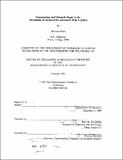Transcription and mismatch repair in the mechanism of action of the anticancer drug cisplatin
Author(s)
Mello, Jill Ann, 1966-
DownloadFull printable version (13.62Mb)
Other Contributors
Massachusetts Institute of Technology. Dept. of Chemistry.
Advisor
John M. Essigmann.
Terms of use
Metadata
Show full item recordAbstract
cis-Diamminedichloroplatinum(II) (cis-DDP or cisplatin) is a powerful cytotoxin and anticancer therapeutic, used most effectively in the treatment of testicular and ovarian cancers. By contrast, the geometric isomer of cisplatin, trans- DDP, is comparatively non-toxic and fails to show significant antitumor activity. Cisplatin is believed to derive its cytotoxic effects from processes triggered by its reaction with DNA. The formation of cisplatin adducts can elicit many cellular responses, including inhibition of both DNA replication and transcription. Cisplatin DNA adducts are also specifically recognized by various proteins within the cell, and such cisplatin-damage recognition proteins have been previously suggested to play a role in the clinical efficacy of the drug. To date, however, the precise mechanism by which cisplatin lesions mediate the cytotoxic and antitumor activities of cisplatin remains elusive. The work in this dissertation evaluated two possible mechanisms by which cisplatin might exert its cytotoxic effects that had been heretofore largely unexplored. The first aspect of this work evaluated a model wherein the differential cytotoxic and antitumor activities of cisplatin and trans-DDP may result from a greater ability of cisplatin DNA damage to inhibit RNA transcription. A nonreplicating plasmid harboring the [beta]-galactosidase ([beta]-gal) reporter gene was modified in vitro with either of the two platinum compounds and transfected into human or hamster cell lines. The use of cell lines both proficient and deficient in nucleotide excision repair allowed the examination of transcriptional bypass independent of excision repair for each platinum compound. A two to three fold higher level of transcription was observed in both cell lines from plasmids containing trans-DDP adducts as compared to plasmids modified by cis-DDP. This difference in transcriptional activity was not decreased in human and rodent nucleotide excision repair deficient cell lines, indicating that more efficient excision repair of the trans- DDP adducts was not the cause of its lower ability to block transcription. The possibility that trans-DDP lesions are preferentially bypassed by RNA polymerase was examined by monitoring the elongation of [beta]-gal mRNA on damaged templates in vivo. Nascent [beta]-gal mRNA transcripts were recovered from nucleotide excision repair deficient xeroderma pigmentosum A cells transfected with platinated plasmids, and the extent of RNA synthesis was measured by using ribonuclease protection. The results showed that four-fold more trans-DDP than cis-DDP adducts were required to inhibit transcription elongation by 63 %. RNA polymerase II translocated past a single, representative DNA adduct of cisplatin and trans-DDP in vivo with an efficiency of 0- 16% and 60-76%, respectively. These data support the view that inhibition of transcription may contribute to the greater cytotoxicity of cis-DDP compared with its trans isomer. The second aspect of this work evaluated a possible novel role of the human mismatch repair protein, hMSH2, as a cisplatin-damage recognition protein. The interaction of purified recombinant hMSH2 with DNA containing adducts of cisplatin and various cisplatin analogs was examined in vitro by using an electrophoretic gel mobility shift assay. The results showed that hMSH2 recognizes and binds specifically to DNA adducts of cisplatin. This protein displayed affinity for DNA modified by therapeutically effective platinum complexes, but not for that modified by clinically inactive platinum compounds such as trans-DDP. Recognition by hMSH2 was dictated, in part, by the major intrastrand DNA adduct formed by cisplatin. The results also show that hMSH2 is overexpressed in testicular and ovarian tissue, tissues in which tumors are best treated by cisplatin. These results complement a growing body of literature correlating mismatch repair activity with cisplatin toxicity in Escherichia coli and mammalian cells. Viewed together, these observations are consistent with a model whereby mismatch repair plays an active role in potentiating cisplatin DNA lesion toxicity. Further, these results may provide insight into a previously undiscovered mechanism by which tumor cells may acquire resistance to CISplatin.
Description
Thesis (Ph. D.)--Massachusetts Institute of Technology, Dept. of Chemistry, 1997. Vita. Includes bibliographical references (leaves 188-212).
Date issued
1997Department
Massachusetts Institute of Technology. Department of ChemistryPublisher
Massachusetts Institute of Technology
Keywords
Chemistry.